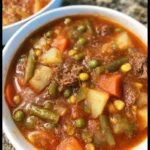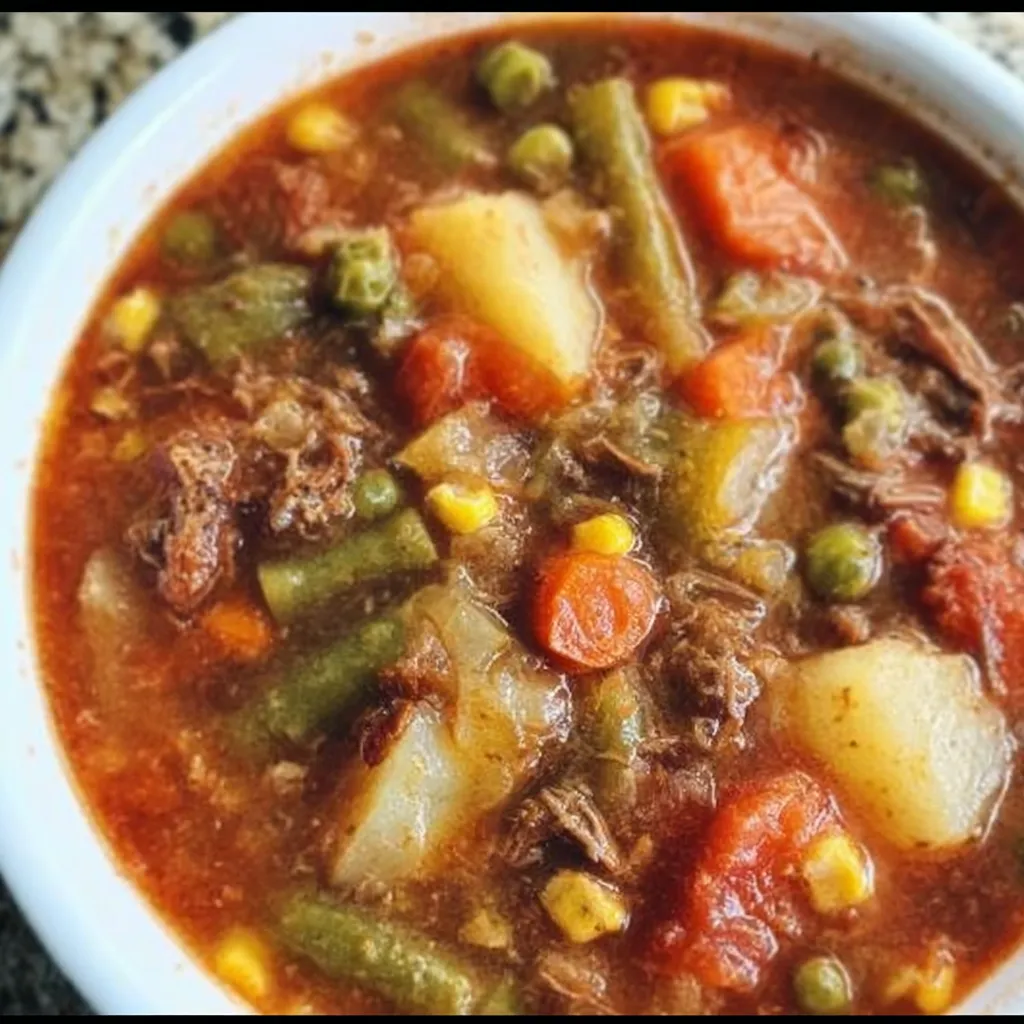There’s something truly special about a simmering pot of old-fashioned vegetable beef soup on the stove. This article delves into the timeless appeal of this hearty dish, exploring its rich history and the secrets to crafting the perfect pot. We will guide you through selecting the best ingredients, mastering the cooking process, and even adapting the recipe to modern tastes. Ultimately, you will discover why this classic comfort food remains a beloved favorite for families across the country.
Table of Contents
Table of Contents
The Heartwarming History of a Humble Dish
I can still vividly remember the distinct aroma that would fill my grandmother’s kitchen on a crisp autumn afternoon. It wasn’t just the scent of simmering beef and fresh vegetables; it was the smell of comfort, of coming home. She’d stand by her ancient, well-loved stockpot, patiently stirring what she simply called her “soup.” To her, it was a practical way to use Sunday’s leftover roast. To me, it was pure magic. That deep, savory broth, tender chunks of meat, and garden vegetables melding together for hours created more than just a meal—it created a core memory. This experience is why an authentic old-fashioned vegetable beef soup recipe feels like a warm hug from the past.
Print
Hearty OldFashioned Vegetable Beef Soup Recipe Easy Delicious
- Total Time: 3 hours 30 minutes
- Yield: 8 servings 1x
Description
Get our easy delicious vegetable beef soup recipe This hearty oldfashioned soup uses simple ingredients for a comforting meal Quick prep tech
Ingredients
Instructions
- Prep Time: 30 minutes
- Cook Time: 3 hours
- Category: Soups
- Cuisine: American
Nutrition
- Calories: 380 calories
- Sugar: 8 g
- Fat: 14 g
- Carbohydrates: 35 g
- Fiber: 6 g
- Protein: 28 g
This dish’s story is woven into the fabric of American home cooking. Long before modern convenience foods, cooks perfected the art of turning humble, affordable ingredients into something extraordinary. They utilized tougher cuts of meat that benefited from long, slow cooking and combined them with root vegetables from the cellar and whatever fresh produce was in season. This wasn’t fancy cooking; it was resourceful, nourishing, and deeply satisfying. Every family has its own version, a recipe passed down through generations, each one claiming to be the best.
What Makes a Soup “Old-Fashioned”?
So, what exactly separates an old-fashioned vegetable beef soup from a quick weeknight version? The key difference is time and technique. An authentic preparation doesn’t rely on shortcuts. It starts with a good bone-in beef shank or chuck roast, which builds a rich, gelatinous broth as it simmers. The vegetables are chopped by hand, not bought pre-diced, and they are added in stages so each one cooks to perfect tenderness without turning to mush. There are no bouillon cubes hiding here—the flavor comes purely from the meat, the vegetables, and a few simple herbs.
A Dish That Builds Community
Beyond its delicious taste, this soup has always served as a symbol of care and community. It’s the dish you bring to a new neighbor, a grieving family, or a friend feeling under the weather. A large pot promises leftovers, ensuring there’s enough to share and enough to provide comfort for days. This tradition of nurturing through food is a beautiful part of the soup’s legacy, connecting us to each other one bowl at a time.
Gathering Your Ingredients for maximum Flavor
Creating an unforgettable pot of soup begins at the grocery store or farmers’ market. Selecting high-quality, fresh components makes a world of difference in the final result. Your shopping list for this old-fashioned vegetable beef soup is a straightforward collection of kitchen staples, but choosing them wisely will elevate your dish from good to extraordinary.
The foundation of any great soup is its broth, and for this recipe, you create it yourself. Opt for a well-marbled, bone-in cut of beef. Chuck roast is a fantastic choice because it becomes incredibly tender and flavorful after hours of slow cooking. Alternatively, beef shanks or short ribs will add incredible depth and body to your broth thanks to the collagen that melts from the bones. For the vegetables, think in terms of layers. Start with a classic aromatic base of yellow onion, carrots, and celery—often called a mirepoix. Then, add sturdy vegetables like potatoes and thick-cut green beans. Finally, incorporate quick-cooking veggies like corn or peas near the end to preserve their brightness and texture.
Choosing the Right Cut of Beef
Don’t be tempted to use lean stew meat from a package. The beauty of an old-fashioned vegetable beef soup lies in using a tougher, fattier cut that transforms through patience. Chuck roast, when simmered for a long time, becomes fall-apart tender and imbues the entire broth with its rich flavor. Brown the large chunk of meat well on all sides before adding water; this crucial step, known as the Maillard reaction, creates a complex, savory base that is the soul of your soup.
The Vegetable Medley
While the recipe is flexible, a traditional combination includes carrots, celery, potatoes, corn, and green beans. However, feel free to add other comfort food staples like peas, diced tomatoes, or even okra. Use fresh vegetables when they are in season for the best flavor, but frozen vegetables are a perfectly acceptable and convenient alternative, especially for corn and peas. The goal is a colorful, hearty mix that offers a variety of textures and tastes in every spoonful.

The Simmering Process: Low and Slow is the Way to Go
Now for the most important step: patience. In our fast-paced world, this old-fashioned vegetable beef soup recipe asks you to slow down. There are no pressure cookers or instant pots in this traditional method—just a heavy-bottomed pot and a gentle flame. After browning your beef and sautéing your aromatics, you add water and bring everything to a boil. Then, you immediately reduce the heat to the lowest possible setting, cover the pot, and let time work its magic.
This slow simmering process, which should take at least two to three hours, is non-negotiable. It allows the tough connective tissues in the beef to break down completely, resulting in meat that is so tender you can shred it with a fork. Simultaneously, the collagen from the bones and meat dissolves into the broth, giving it a luxurious, slightly viscous body that is far superior to any broth made from a cube or box. This method coaxes every bit of flavor from each ingredient, creating a harmonious and deeply developed soup.
Layering in the Vegetables
If you add all the vegetables at once, you’ll end up with a mushy, overcooked mess. To achieve perfect texture, add your vegetables in stages based on how long they need to cook. The carrots and celery go in early with the aromatics. Dense potatoes and green beans should go in about halfway through the simmering time. Finally, delicate vegetables like frozen corn or peas should be stirred in during the last 15-20 minutes of cooking. This ensures every element of your soup is cooked to perfection.
The Final Seasoning Touch
Hold off on adding too much salt until the very end. As the soup reduces, the flavors concentrate. What tastes underseasoned at the beginning might become perfectly seasoned after a few hours. Right before serving, taste your creation and adjust the seasoning with salt and black pepper. A bay leaf added during simmering provides a subtle, classic background note—just remember to remove it before serving! A sprinkle of fresh parsley on top adds a welcome burst of color and freshness.

Modern Twists and Serving Suggestions
While tradition is wonderful, every cook deserves to put their own stamp on a recipe. This versatile old-fashioned vegetable beef soup welcomes creativity. For a richer, deeper flavor, substitute a cup of water with a dry red wine like a Cabernet Sauvignon or add a tablespoon of tomato paste to your sautéing vegetables. If you enjoy a bit of heat, a pinch of red pepper flakes or a dash of hot sauce can add a nice kick. You can even explore other hearty soup recipes for inspiration on flavor combinations.
Transforming this soup into a complete meal is effortlessly easy. Of course, a thick, crusty slice of buttered bread or a fluffy homemade biscuit is the classic pairing, perfect for sopping up every last drop of the delicious broth. For a lighter option, serve it alongside a simple green salad with a tangy vinaigrette to cut through the soup’s richness. No matter how you serve it, this soup is the definition of satisfying family meals.
Making It Your Own
Don’t be afraid to experiment with herbs. While thyme and bay leaf are traditional, rosemary or a touch of oregano can create a different flavor profile. You can also add a parmesan rind to the pot while it simmers; it will melt into the broth, adding a wonderful umami depth. For a thicker, stew-like consistency, you can mash some of the potatoes against the side of the pot or add a slurry of flour and water at the end.
Storage and Reheating Tips
One of the best things about this soup is that it tastes even better the next day. Allow the soup to cool completely before storing it in an airtight container in the refrigerator, where it will keep for up to 4 days. The flavors continue to meld and develop, making leftovers a highly anticipated event. This soup also freezes beautifully for up to 3 months. Simply thaw it overnight in the refrigerator and reheat it gently on the stove, adding a splash of water or broth if it has thickened too much.
Frequently Asked Questions
Can I make this old-fashioned vegetable beef soup in a slow cooker?
Absolutely. After browning the beef and sautéing the onions, transfer everything to your slow cooker. Add the harder vegetables and cover with water or broth. Cook on low for 7-8 hours or on high for 4-5 hours. Add the softer vegetables like peas or corn in the last 30 minutes of cooking.
What is the best way to thicken this soup?
The soup should naturally have some body from the potatoes and the collagen from the beef. However, if you prefer a thicker consistency, you can make a simple slurry. Mix two tablespoons of cornstarch with an equal amount of cold water until smooth. Stir this into the simmering soup and cook for a few minutes until it thickens.
Can I use ground beef instead of stew meat?
You can, but it will create a different type of soup. Using ground beef will result in a lighter broth and a different texture, more akin to a hamburger soup. For the classic, hearty feel and rich broth, a chuck roast or stew meat is highly recommended.
My soup seems greasy. How can I fix it?
The fat from the beef can sometimes rise to the top. The best method to remove it is to chill the soup. After cooling, the fat will solidify on the surface, making it very easy to scoop off. You can also use a fat separator while the soup is still liquid, or gently skim the surface with a spoon.
Ultimately, a perfect pot of old-fashioned vegetable beef soup is more than the sum of its parts. It’s a testament to patience, a celebration of simple ingredients, and a warm, nourishing bowl of history. It connects us to the cooks who came before us and provides a sense of comfort that is truly timeless. So, find your heaviest pot, gather your ingredients, and dedicate an afternoon to the slow, rewarding process. The incredible aroma filling your home and the satisfied smiles around your table will be more than worth the effort.